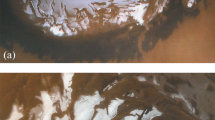Abstract
Synoptic images of the Martian volcano Olympus Mons are of a quality and quantity that are unique for mars and, somewhat surprisingly, are appreciably better than image data that exist for many volcanoes on Earth. Useful information about the evolution of shield volcanoes on Earth can thus be derived from the investigation of this extraterrestrial example. We have used shadow-length measurements and photoclinometrically derived profiles to supplement and refine the topographic map of the Olympus Mons caldera. As much as 2.5 km of collapse took place within the 80×65 km diameter caldera and the elevation of the caldera rim varies by almost 2.0 km (low around the oldest collapse events, high around the youngest). An eight-stage evolutionary sequence for the caldera of Olympus Mons is identified which shows that caldera subsidence was a longterm process rather than the near-instantaneous event that has been interpreted from comparable terrestrial examples. Tectonic features on the caldera floor indicate a transition from an extensional environment (graben formation) around the perimeter of the caldera to compression (ridge formation) towards the caldera center. This transition from a compressional to extensional environment is surprisingly sudden, occurs at a radial distance of ∼17 km from the caldera center, and is import because it can be used to infer that the magma chamber was relatively shallow (thought to be at a depth of <∼16 km beneath the caldera floor; Zuber and Mouginis-Mark 1990). Ample evidence is also found within the Olympus Mons caldera for solidified lava lakes more than 30 km in width, and for the localzed overturning and/or withdrawal of lava within these lakes.
Similar content being viewed by others
References
Carr MH (1981) The surface of Mars. Yale University Press, New Haven, Connecticut, 232 pp
Carr MH, Greeley R (1980) Volcanic features of Hawaii: a basis for comparison with Mars. NASA SP-403, 211 pp
Crumpler LS, Aubele JC (1978) Structural evolution of Arsia Mons, Pavonis Mons and Ascraeus Mons: Tharsis region of Mars. Icarus 34:496–511
Davis PD, Soderblom LA (1984) Modeling crater topography and albedo from monoscopic Viking Orbiter images 1. Methodology. J Geophys Res 89:9449–9457
Greeley R, Spudis PD (1981) Volcanism on Mars. Rev Geophys Space Phys 19:13–41
Holcomb RT (1987) Eruptive history and long-term behavior of Kilauea Volcano. Volcanism in Hawaii, US Geol Surv Prof Pap 1350:261–350
Knight MD, Walker GPL (1988) Magma flow directions in dikes of the Koolau Complex, Oahu, determined from magnetic fabric studies. J Geophys Res 93:4301–4319
Mouginis-Mark PJ (1981) Late-stage summit activity of martian shield volcanoes. Proc Lunar Planet Sci, 12B:1431–1447
Mouginis-Mark PJ, Robinson MS, Zuber MT (1990) Evolution of the Olympus Mons Caldera, Mars (abstract) Lunar Planet Sci XXI:815–816
Mouginis-Mark PJ, Wilson L, Zuber MT (1991) The physical volcanology of Mars. In: Mars, University of Arizona Press, Tucson, AZ, in press
Peck DL, Kinoshita WT (1976) The eruption of August 1963 and the formation of Alae Lava Lake, Hawaii. US Geol Surv Prof Pap 935-A
Plescia JB, Golombek MP (1986) Origin of planetary wrinkle ridges based on the study of terrestrial analogs. Geol Soc Am Bull 97:1289–1299
Robinson MS (1990) Precise topographic measurements of Apollinaris and Tyrrhena Patera, Mars (abstract). Lunar Planet Sci XXI:1027–1028
Scott DH, Carr MH (1978) Geologic Map of Mars. US Geol Surv Misc Map I-1083
Sharpton VL, Head JW (1988) Lunar mare ridges: analysis of ridge-crater intersections and implications for the tectonic origin of mare ridges, Proc Lunar Planet Sci Conf 18:307–317
Simkin T, Howard KA (1970) Caldera collapse in the Galapagos Islands, 1968. Science 169:429–437
Walker GPL (1987) The dike complex of Koolau volcano, Oahu: internal structure of a Hawaiian rift zone, US Geol Surv Prof Pap 1350:961–993
Walker GPL (1988) Three Hawaiian calderas: an origin through loading by shallow intrusions? J Geophys Res 93:14773–14784
Wood CA (1984) Calderas: a planetary perspective. J Geophys Res 89:8391–8406
Wu SSC, Garcia PA, Jordan R, Schafer FJ, Skiff BA (1984) Topography of the shield volcano, Olympus Mons on Mars. Nature 309:432–435
Zuber MT, Mouginis-Mark PJ (1990) Constraints on the depth and geometry of the magma chamber of the Olympus Mons volcano, Mars (abstract). Lunar Planet Sci XXI:1387–1388
Author information
Authors and Affiliations
Rights and permissions
About this article
Cite this article
Mouginis-Mark, P.J., Robinson, M.S. Evolution of the Olympus Mons Caldera, Mars. Bull Volcanol 54, 347–360 (1992). https://doi.org/10.1007/BF00312318
Received:
Accepted:
Issue Date:
DOI: https://doi.org/10.1007/BF00312318




